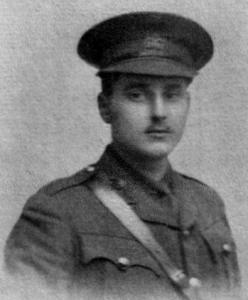
|

|
| Lieutenant Edward Harold DE FONTAINE | |
|
1/19th (County of London) Battalion (St Pancras) Date of birth: 26th February 1894 Date of death: 17th November 1915 Died of wounds aged 21 Buried at Le Treport Military Cemetery Plot 2 Row O Grave 25 |

|
| Edward Harold De Fontaine was born at Christ Church Rectory in Southwark on the 26th of February 1894 the third and youngest son of the Reverend Alfred Hutchings De Fontaine, Rector of Christ Church, and Sarah (nee Tilsley) De Fontaine later of Bletchingley Rectory, Bletchingley in Surrey. He was christened by his father at Christ Church, Southwark on the 23rd of March 1894. He was educated at Lancing College where he was a Branthwaite Scholar and was in Olds House from May 1905 and followed Mr. Ferguson to News House from September 1910 until April 1912. He was a Colour Sergeant in the Officer Training Corps and was appointed as a House Captain in 1911. He was Secretary of the Debating Society. On leaving school he won a Scholarship to Magdalen College Oxford in 1912 where he read for Holy Orders (Academical Clerkship). He abandoned his plans for the church when war broke out and instead he volunteered for war service and was commissioned as a 2nd Lieutenant in the 19th (County of London) Battalion (St Pancras) on the 17th of September 1914. He was promoted to Lieutenant on the on the 5th of December 1914 and embarked for France on the 15th of April 1915 where he was battalion Signalling Officer. On the 25th of September 1915 the British launched a major attack on the German lines at Loos in Northern France. At 5.30am gas was released, the first time it had been used by the British, but due to the wind it drifted back over the lines of the 15th (Scottish) Division who were on the left of the 1/19th (County of London) Battalion (St Pancras). The Londons went over the top at 6.30am and suffered a large number of casualties crossing no man's land before taking the German first line at Loos Cemetery and becoming involved in street fighting in the village of Loos itself. The rest of the day was spent consolidating their gains and beating off local counter attacks. Casualties were 14 officers, including the Commanding Officer of the battalion, Lieutenant Colonel Harold Duke Collison-Morley, and 372 other ranks killed wounded and missing. Edward De Fontaine was badly wounded in the charge across no man's land, was evacuated to the rear, and died at No.3 British Military Hospital at Le Treport on the 17th of November. He was buried with full military honours the following day. Sir Herbert Warren, President of Magdalen College wrote of him:- “I have always thought him one of the very best and most attractive of out men; indeed, I do not think we have ever had one I have liked better or thought more satisfactory. If he is still living, give him my love. I can say no less. Lady Warren is also much concerned. “ His tutor wrote:- “We are all so fond of him and think so much of him I am sure you will be pleased to know that he set a very high example here of reverence and devotion.” His brother applied for his medals in November 1919. He is commemorated on the war memorial at Bletchingley and on a brass plaque at St Mary's Church, Bletchingley. |
|
| News House |
Back